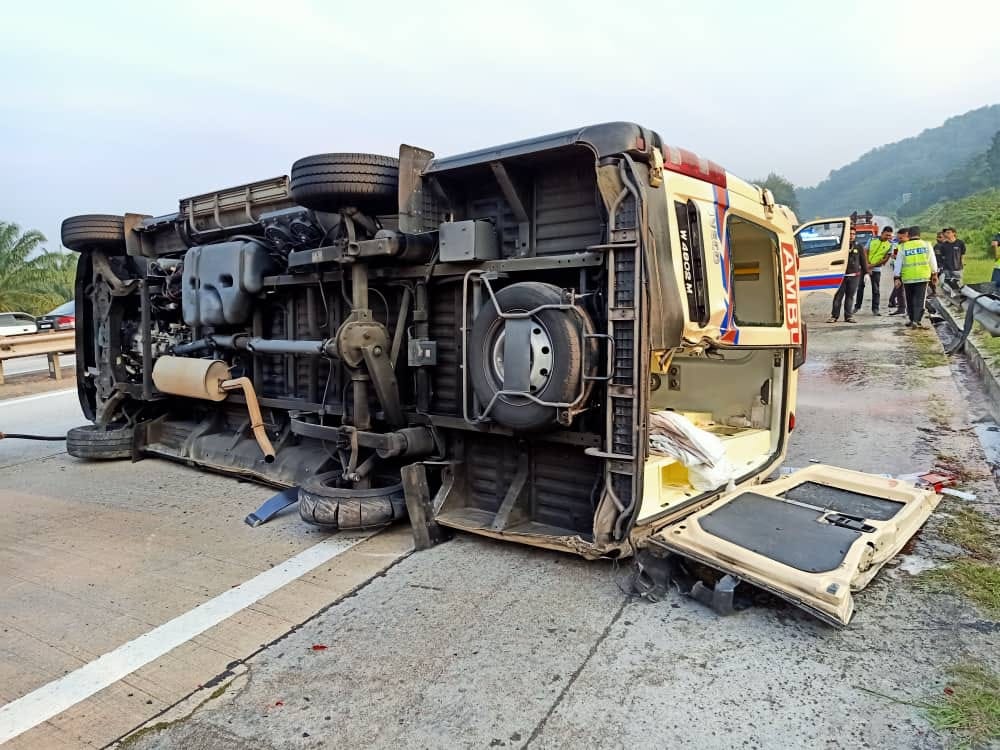At first glance, the news of a fatal ambulance crash in Slim River, Perak, on August 4 seemed like an everyday road traffic accident story.
I didn’t pay much heed to it until someone posted photographs of what looked like a tyre tread that had come off the ambulance’s burst tyre, sparking speculation as to whether the Slim River Hospital ambulance had used a retreaded tyre (tayar celup).
So, I started digging deeper. Eight Slim River Hospital staff told me that an ambulance had, in fact, suffered a tyre blowout just one week before the fatal August 4 crash. They claimed this happened a few times this year, and a few more times last year.
The government hospital staff were clearly angry that authorities appeared to blame their colleague, the ambulance driver who perished in the crash along with a patient. These health care workers poured out their frustrations to me about the allegedly shoddy maintenance of the ambulances, with one describing his fear of working in those “silent killer” vehicles every day. The workers’ complaints about poor maintenance, they claimed, were often ignored.
UEM Edgenta – the government-linked company (GLC) under Khazanah that has a 10-year concession with the Ministry of Health (MOH) to maintain vehicles in 32 MOH hospitals in the northern region, among other hospital support services – has yet to issue a statement, despite my repeated attempts to contact them.
And just two days after my story about Slim River Hospital ambulances’ multiple tyre explosions came out Monday, an ambulance from the MOH hospital got yet another tyre burst!
The Slim River Hospital story isn’t unique. In July last year, a Sultan Abdul Halim Hospital ambulance got into a fatal road accident after its tyre exploded, killing a patient.
Yet, in my conversations with the hospital staff, some seemed totally blasé about tyre blowouts: “Tayar pecah jer”. It appears as if burst tyres are a normal occurrence among ambulances, which is frightening. Just how safe are Malaysia’s public ambulances?
Never mind the long wait times at government hospitals, now do we have to fear that we may never even get to the hospital in the first place if an ambulance picks us up for an emergency? Then there are poor patients living outside major towns and cities, like Slim River, who are transported via ambulance to larger hospitals for non-emergency matters like CT scans.
The public don’t seem very fussed about Slim River Hospital ambulances’ many tyre blowouts either. Perhaps it’s because few of us use the ambulance. Vehicle maintenance isn’t a very “sexy” topic either. Malaysians have a “tidak apa” attitude when it comes to standards and maintenance.
Plus, we have gotten used to dangerous roads. Malaysia reportedly has the third highest fatality rate from road traffic accidents in Asia. According to the World Health Organization’s Global Status Report on Road Safety 2018, Malaysia’s estimated road traffic death rate per 100,000 population in 2016 was 23.6. Compare this to Singapore’s rate of only 2.8, Indonesia (12.2), or Philippines (12.3).
We also rarely hold people accountable for negligence, even when it results in death.
If the fatal ambulance accident had happened in the United States, the victims’ families would probably have filed a lawsuit.
So, government officials and powerful corporations in Malaysia get away with a lot of things.
Deputy Health Minister Dr Lee Boon Chye promised to investigate Slim River Hospital ambulances’ multiple tyre bursts. I certainly hope MOH thoroughly probes the ambulance maintenance in its hospital, instead of looking for the whistle-blowers who risked their jobs to speak out simply because they were terrified for their lives.
MOH can start by publishing useful statistics about ambulance accidents, like the number of deaths involved instead of just listing whether the crashes caused injuries. Otherwise, how can MOH make meaningful policy to improve vehicle safety?
The front liners in health care who aim to rescue people in emergencies by rushing them to hospital deserve to work in a safe environment. Our doctors, nurses, senior health care assistants (PPK), and ambulance drivers should not have to risk their lives to save other people.
Workers’ safety should be more important to MOH than some concession. Decade-long concessions are also ridiculous as they will only breed mediocrity. Why bother competing with better products and services when you have a comfy 10-year contract? Government concessions should be no more than three to five years’ long. But public procurement is a topic for another day.
For now, it would suffice for MOH to start protecting their workers and patients, and to ensure that concessionaires don’t give crappy services paid for by taxpayers’ ringgit.

Boo Su-Lyn is CodeBlue editor-in-chief. She is a libertarian, or classical liberal, who believes in minimal state intervention in the economy and socio-political issues.








